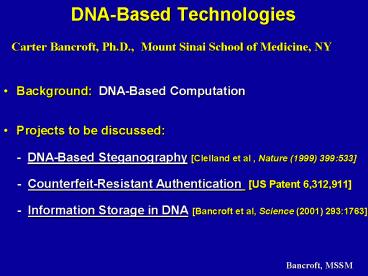DNABased Technologies - PowerPoint PPT Presentation
1 / 17
Title: DNABased Technologies
1
DNA-Based Technologies
Carter Bancroft, Ph.D., Mount Sinai School of
Medicine, NY
- Background DNA-Based Computation
- Projects to be discussed
- - DNA-Based Steganography Clelland et al ,
Nature (1999) 399533 - - Counterfeit-Resistant Authentication US
Patent 6,312,911 - - Information Storage in DNA Bancroft et
al, Science (2001) 2931763
Bancroft, MSSM
2
Properties of DNA as a Technological Tool
- DNA is the central repository of information in
the cell. - DNA stores information efficiently. Four
different bases (A, T, G, and C) imply 4n
possible different n-mers. - A large number of elements (DNA strands)
occupies a small - space 1012 strands in about 100ul (1/
10th of a marble). - Hybridization between two DNA strands is strongly
- sequence- specific. Only complementary
strands will hybridize
Strand A
Strand A
DNA
- c.
Complement of Strand A
Strand B (not A complement)
Bancroft, MSSM
3
A Brief History of DNA-Based Computation
- 1994 Field begins with Adleman paper in Science
Molecular computation of solutions to
combinatorial problems. - 1995- Use of DNA for
- - Addition (Bancroft et al, Science 1996)
- - Combinatorial problems, either in solution
(e.g., Kaplan et al, Science 1997) or on
surfaces - (Condon and Smith, Nature 2000)
- - Logic (e.g., Seeman and Reif, Nature 2000)
- c.
Bancroft, MSSM
4
Computer Killer Applications
Silicon
DNA
?
Spreadsheets
Word processing
Parallel processing? Memory storage?
E-mail, Internet
(And dont forget quantum molecular
computers)
Expanded definition of the field.
Bancroft, MSSM
5
DNA-Based Technologies
Information Storage
Computation
Self-Assembly
Cryptography
(Seeman)
Steganography
Text/Data Storage
Logic
Addition
Combntrial
(Adleman et al)
(Bancroft)
(Seeman Reif)
Counterfeit-Resistant Authentication
Bancroft, MSSM
6
I. DNA-Based Steganography
- Background
- Most current cryptosystems are based upon
intractable NP-complete problems, and are thus
theoretically subject to attack by quantum
computers. - Summary
- We have developed DNA-Based Steganography-
a method for camouflaging a DNA-encoded message
within the enormous complexity of the human
genome. - We believe that breaking DNA-based
steganography represents an intractable
biochemical problem, and that this technique is
thus highly resistant to either computer
(quantum, etc.) or biochemical attacks.
- c.
Bancroft, MSSM
7
(No Transcript)
8
(No Transcript)
9
DNA-Based Steganography
Apply to Microdot
DNA-Based Steganography
Secret Message DNA
Human DNA (fragmented/denatured)
F primer
R primer
Encoded Message
100 bases
.
(30 x106 100-base strands per haploid genome)
Bancroft, MSSM
10
ACGA KAAG UCTG 0ACT BCCA LTGC VCCT 1ACC
CGTT MTCC WCCG 2TAG DTTG NTCT XCTA 3GCA
EGGC OGGA YAAA 4GAG FGGT PGTG ZCTT 5AGA
GTTT QAAC ATA 6TTA HCGC RTCA ,TCG 7ACA
IATG SACG .GAT 8AGG JAGT TTTC GCT 9GCG
(From Clelland et al, Hiding Messages in DNA
Microdots. Nature 399533 1999)
c
a
Message Input (copies/genome)
Encoded Message
Total DNA
5
3
F Primer
R Primer
100
0.1
1.0
10
M
bp
0
b
Encryption Key
300
200
100
1 2 3 4 5 6 7
d
J U N E 6 I N V A S
I O N N O R M A N D Y
11
Extension of DNA-Based SteganographyCounterfeit-
Resistant Authentication
Potential uses Authenticate documents (e.g.,
currency, immigration documents) solid objects
(e.g., apparel, industrial parts) liquids (e.g.,
signatures, perfume, petroleum)
Authentication Oligomer plus vast excess
of concealing oligos
1. Readout PCR c. specific primers 2.
Counterfeiting virtually impossible, since
adversary cant detect, recover, or sequence the
Authentication Oligomer
.
Bancroft, MSSM
12
Current Use of DNA Microarrays in Biology Gene
Expression Patterns ( Signatures)
DNA Microarrays
- A robot spots up to 10,000 gene DNA samples onto
a 2 cm2 area on glass or filter. - The array is hybridized with colored cellular RNA
probe(s) (red and/or green). - Colors represent the degree of hybridization over
each spot, yielding a unique, complex gene
expression pattern or signature.
Example from our lab prostate cancer gene
expression (two 2400 spot analyses)
- c.
MSSM
Bancroft, MSSM
13
Use of Microarrays in DNA-Inspired Technologies
IDiscreet Authentication Tags Containing DNA
Microarrays
Microarray is on removable filter. All spots
contain concealing DNA only a pattern of spots
contains authentication oligomer.
Glass support
Removable filter
1. Remove filter tag from glass, attach to item
to be authenticated. 2. Authentication (Level
1) Determine whether primer extension
with specific primer yields expected spot
pattern. 3. Authentication (Level 2)
Determine whether primer extension
product contains the correct authentication
sequence.
.
Bancroft, MSSM
14
III. Storage/Retrieval of Information in DNA
- Purpose To store information efficiently in
DNA, in a form that - permits ready retrieval and
interpretation. - Rationale Any computer-based medium will
ultimately become - obsolete, but DNA will never fall into
disuse. - Fundamental Design Employ two types of DNA
strands - - n Information Strands encoding the
information to be stored. - - A single Polyprimer Strand key to
the Information Strands. - This strand encodes primers for the
Information Strands, plus - order of Info Strands (and thus order
of encoded information). - Storage Medium Microcentrifuge tubes
ultimately DNA microarrays
- c.
Bancroft, MSSM
15
Long-Term Storage of Information in DNA
(From Bancroft et al (2001).
Science 2931763-1765)________
Polyprimer Key
Information DNAs
F Primer Seq Primer 1 Seq
Primer 2 Seq Primer 3 Seq Primer
n R Primer
16
Generalization of DNA Storage Scheme to DNA
Microarrays (Use of Microarrays in DNA-Based
Technologies II)
Use a Single Polyprimer Strand (containing n
primers)
to retrieve info (yellow) from n Info DNA
Strands in each of 10,000 spots
Bancroft, MSSM
17
Summary
- We are working in a broad discipline that
includes DNA-Based Computation as a subset,
termed DNA-Based Technologies. - We have developed three new DNA-based
technologies - DNA-Based Steganography, for hiding
DNA-encoded messages in concealing DNA (genomic
or synthetic). - Counterfeit-Resistant Authentication (derived
from DNA Steganog.), for authenticating valuable
objects or liquids - DNA Information Storage, a DNA-based technique
for long-term storage of information (text, etc.).
- c.
Bancroft, MSSM































